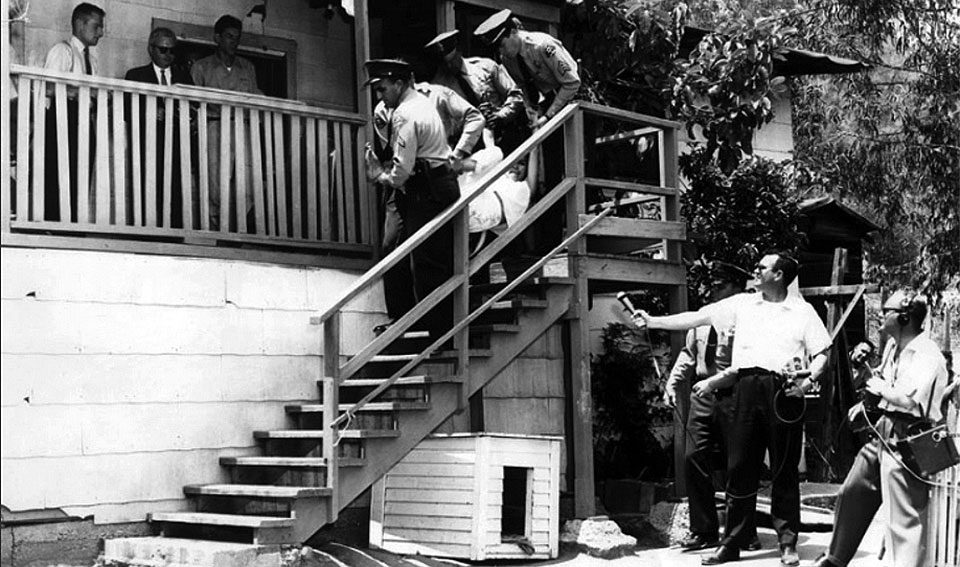
“The story of Dodger Stadium has been condensed and mythologized. It has become—with good reason—like a fable. The real history is less like a fable and more like the story of a crime that Los Angeles perpetuated on itself.”
As a junior in high school in Culver City, Calif., Eric Nusbaum heard Frank Wilkinson speak to his class about the dark, terrifying years of McCarthyism. At one point, Wilkinson asked if any of the students were Dodger fans. Nusbaum raised his hand. Then Wilkinson made a statement that stunned him:
“Dodger Stadium should not exist.”
What? The ballpark where he spent a lot of his free time rooting for his favorite baseball team should never have been built? Years later, in the preface to his book, Nusbaum wrote, “On some level, I think I have wanted to write this book since the day I saw Frank Wilkinson in high school.” We are fortunate that he has done the research and conducted the interviews that resulted in this disturbing, infuriating, and yet life-affirming book, Stealing Home: Los Angeles, the Dodgers, and the Lives Caught in Between.
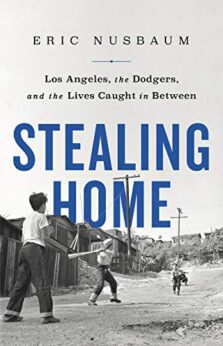 In very short (2-3 page) chapters, this account of the creation, growth, and destruction of three thriving Mexican-American neighborhoods reads more like a gripping novel than straightforward nonfiction. Nusbaum interweaves the stories of a number of people whose lives were irrevocably changed by the events recounted here.
In very short (2-3 page) chapters, this account of the creation, growth, and destruction of three thriving Mexican-American neighborhoods reads more like a gripping novel than straightforward nonfiction. Nusbaum interweaves the stories of a number of people whose lives were irrevocably changed by the events recounted here.
In the 1920s, there arose several communities of Mexican immigrants who bought land in what was known as Chavez Ravine, a group of hills not far from downtown Los Angeles. They built their own houses, largely with money they made picking fruit and vegetables as far away as Fresno and Stockton in the summer.
There was not much there in those hills except dirt and a brickyard, spewing toxic smoke when Manuel and Abrana Arechiga pitched their tent. It took several years of hard work, but they were finally able to live in a house of their own.
Other Mexicans were doing the same thing on this inhospitable land, and within a few years, they had created three distinct neighborhoods: Palo Verde, La Loma, and Bishop. Of course, they were ignored by the City of Los Angeles, but they continued to grow. There was an elementary school, Elysian Park, and Santo Niño Catholic Church, the heart of all three communities. The streets remained unpaved, there was no bus service, but there was mail delivery, and people were largely left alone—until July 1950.
Residents began to get notices telling them they were going to have to move as new public housing units—the Elysian Park Heights Development—were to be built on their land.
By 1950, the population of Los Angeles had increased from 1.5 million in 1940 to 2 million. There was just not enough housing for the rapidly growing number of the city’s inhabitants. The federal government was well aware of this as there was a postwar housing shortage throughout the country. So Congress passed the American Housing Act of 1949, which provided money for 800,000 public housing units. The bill was sponsored by Ohio Republican Senator Robert Taft—which just shows how far the Republican Party has fallen.
Los Angeles was to receive enough funds to build 10,000 new public housing units. There were a number of areas in L.A. that were considered to be “slums,” but they were in industrial zones, so public housing could not be built there. But there was one place in Los Angeles that appeared to be a perfect fit: the communities of Palo Verde, La Loma, and Bishop, all located in Chavez Ravine.
Enter Frank Wilkinson, the speaker in Nusbaum’s history class. His story is central to the tragedy that was to come. Wilkinson had been an advocate for public housing, and when the notices to vacate were sent to these residents, Wilkinson was the deputy to the L.A. Housing Authority Executive Director and was also its Public Information Director. He was zealous in his belief that public housing would revitalize local communities, so he went door-to-door in Palo Verde, La Loma, and Bishop—along with his interpreter, local activist Ignacio Lopez—to try to convince them that they should give up their land as it would ultimately be better for so many more people, as well as themselves, who did not have homes.
Frank Wilkinson was not a liberal do-gooder: he was a committed Communist. He had traveled through Europe as a college student and, after visiting the USSR, decided that socialism was the future and joined the Communist Party. Unlike some members, he remained a Communist for the rest of his life.
But many residents of these neighborhoods in Chavez Ravine did not agree with Wilkinson. Some sold their homes to the city right away, but others refused to move and fought back. Manuel and Abrana were particularly vocal, but to no avail: the Elysian Heights Development was approved by the planning commission. And even if the Arechigas decided to sell, their 3 adjoining lots and 2 houses that an independent appraiser valued at $17,500 was lowered to $10,500 by a judge. But at this point they were not going to sell for any price: they were going to stay.
When opponents of public housing found out about Wilkinson’s Party membership, and his commitment to racial integration, they—with help from the FBI—conspired to destroy his career. He was fired in October 1952 after testifying before the House Un-American Activities Committee. Public housing’s fiercest proponent had been silenced.
Wilkinson’s firing was the beginning of the end for public housing in Los Angeles. While Mayor Fletcher Bowron supported the Elysian Park Heights Development, the city’s real estate interests, led by Los Angeles Times owner Norman Chandler, were dead set against it. Chandler was instrumental in getting a Republican congressman, Norris Paulson, to run against Bowron and provided him with however much money he might need to win.
Bowron was smeared as a Communist sympathizer because of his support for the “communist” public housing plan and was defeated by Paulson. The city’s business elite celebrated as Paulson canceled the project and bought the land back from the federal government.
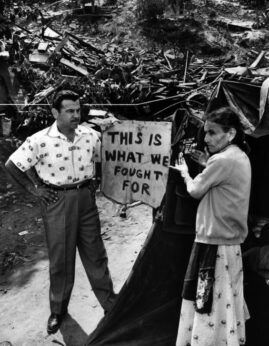
(Herald-Examiner Collection/Los Angeles Public Library Collection)
Much of Chavez Ravine had been bulldozed by this time, so the residents of Palo Verde, La Loma, and Bishop had lost their land for nothing: there would be no public housing, or housing for anyone, there.
Many uses for the land were discussed: a zoo, a jail, an airport, an auditorium, and even a world’s fair. But the city’s moneyed establishment saw an opportunity to attract a major league baseball team, as Brooklyn Dodgers owner Walter O’Malley was ready to move his club to the West Coast in search of greater profits. O’Malley owned the minor league Los Angeles Angels and their Wrigley Field ballpark, and the city offered him the 300-acre Chavez Ravine site in exchange for his 10-acre Wrigley Field. Such a sweet deal was too good for O’Malley to pass up and, after a number of lawsuits, the California Supreme Court ruled in favor of the Dodgers owner. Chavez Ravine was now his.
On May 8, 1959, Manuel and Abrana Arechiga watched as their house—which they had built and where they had lived for over 30 years, and where their children had grown up—was demolished by a bulldozer in ten minutes.
The Arechigas and the other displaced families of Palo Verde, La Loma, and Bishop had lost. The city’s corporate masters and Walter O’Malley had won. In September 1959, the victors held a groundbreaking ceremony. And three years later, O’Malley’s brand-new ballpark, Dodger Stadium, opened on April 10, 1962—exactly 60 years ago this month.
Manuel Arechiga died in 1971.
“In August 1972, fifty years after she had come to Los Angeles, but now without her home and without her husband, Abrana Arechiga died…. She was buried next to Manuel. On a hill, of course.”
An interview with Eric Nusbaum can be viewed here.
Stealing Home: Los Angeles, the Dodgers, and the Lives Caught in Between
By Eric Nusbaum
Public Affairs, 2020
353 pp.



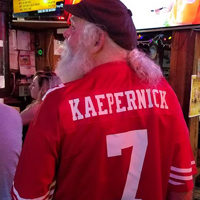


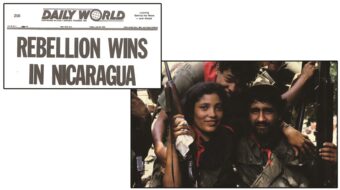





Comments